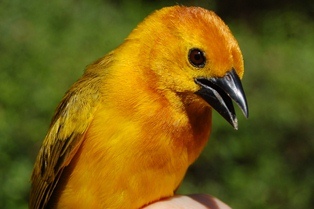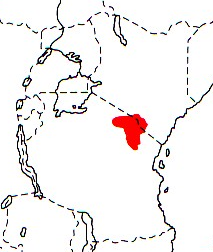Weaver Wednesday [36]: Taveta Golden Weaver
2013-02-20 (334)
 Weaver Wednesday
Weaver Wednesday


The Taveta Golden Weaver Ploceus castaneiceps is a bright yellow weaver with a very restricted range in southern Kenya and northern Tanzania. The male is golden yellow, with chestnut crown ending in sharply defined crescent on nape, and chestnut band on breast. Female is yellow without orange and heavily streaked back and 2-tone bill (dark above, yellowish below). The juv. browner above, buffy below. In captive birds Male nestlings on day 14 were heavier than female nestlings, with little overlap, but sample sizes were small (7 males, 13 females - see Sex of Taveta Golden Weaver chicks).

More measurements are needed for this species - a sample of 7 males ringed near Arusha had larger wing and tail and shorter bills than the measurements provided for 8 males (possibly museum specimans) in Birds of Africa). It was first collected near the town Taveta, giving rise to its English name.
No subspecies of the Taveta Golden Weaver are recognised, although one other has been proposed. It is common but very local. In Kenya, it is found in the Amboseli and Taveta areas, and Lake Jipe. In Tanzania, it occurs along the Pangani River, around Mt Meru and Kilimanjaro (see map left, based on Birds of Africa).
The Taveta Golden Weaver inhabits woodland and dry bush country, and moves into swampy lowlands to breed. The diet is seeds, including grass seeds, and maize, and ants have been recorded.

The Taveta Golden Weaver is probably polygynous. It breeds in colonies in swampy or flooded areas. Breeding areas may be deserted suddenly and completely, for weeks or months at a time. It is not clear if this follows a regular pattern in Tanzania. The nest is spherical or ovoid with no entrance tube but a slight porch. The nest is woven of strips of reed leaf-blades. Nests are usually suspended over water in reedbeds or bulrushes, and sometimes in low trees overhanging water.
The Taveta Golden Weaver has 2 PHOWN records. One record provides the first colony size (20 nests in this case). Many more PHOWN records are needed for this species (see PHOWN summary), especially to document colony size. Submit any weaver nest records to PHOWN (PHOtos of Weaver Nests) via the Virtual Museum upload site.
PHOWN summary
Previous Wedn: Dark-backed Weaver
Full weaver species list
| 

 Weaver Watch
Weaver Watch


